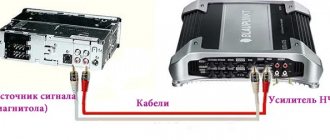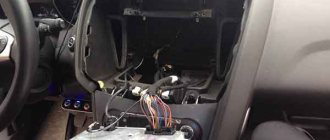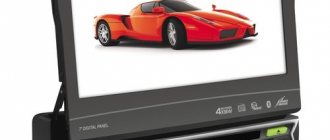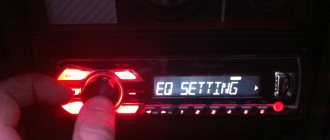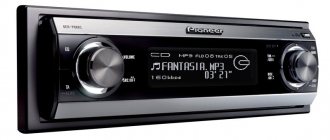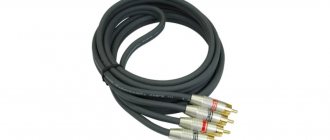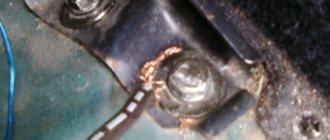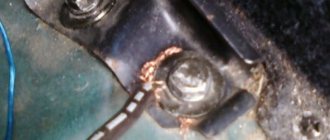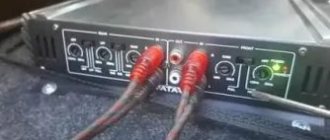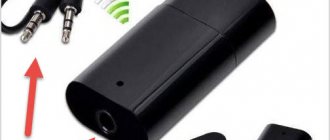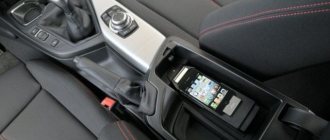Articles
- 2 Criteria for selecting an amplifier
- 3 Which amplifier to choose if a subwoofer is installed
- 4 Sound noise
4.1 What you need to connect
- 4.2 Connecting the amplifier
How to connect an amplifier and subwoofer to a car radio
Many car owners are well aware of how expensive it is to equip them with various accessories and maintain them. Some, in order to save money, and others, out of love for technology, try to do everything with their own hands that does not require the use of special expensive equipment. The instructions and videos on the pages of our website will tell you how to connect a subwoofer and amplifier to a car radio. This is the question readers ask most often.
Types and principle of operation
Before you get down to business, you should understand the principle of operation of the amplifier. Unlike stationary devices that operate on a 220-volt network, a device for a car is connected to the on-board network. The voltage here reaches only 12 volts. So the job of the amplifier is to take the weak signal and convert it into one that is suitable for driving the speakers. An important detail is that the received and converted signal differ not in wavelength, but only in its amplitude.
The internal structure of the amplifier consists of 3 elements:
- input circuit;
- power unit;
- output stage.
Input circuit. The amplifying device must be able to process signals of different levels. This is explained by the fact that the radio signals at the linear level can have different voltages. High level signals go directly to the load; if the level is low, the signal needs to pass through an amplifier.
In this case, it is important to take into account the correspondence of the signal level supplied from the head unit and the sensitivity of the input node.
Power unit. In operating condition, this unit converts low battery voltage into a higher voltage. For this purpose, the power supply is equipped with a transformer. An important feature of the sound signal is its variability, and therefore the functioning of the speakers requires 2 voltages at once: + and -. To achieve such conditions, voltages of different polarities are removed from the transformer. Their combination is used to obtain an alternating signal.
Output stage. This working unit includes powerful transistors, thanks to which increased voltage is supplied. This becomes possible due to the conversion of incoming signals
Manufacturers offer dozens of amplifier models with varying technical characteristics. According to the method of signal amplification, devices are divided into 2 categories:
- analog;
- digital.
Another classification is based on the quantitative difference between channels.
- Single channel. Such devices are designed for a nominal load of up to 2 ohms and are equipped with a volume control. More often, single-channel amplification devices are used to connect subwoofers.
- Two-channel. You can connect such a device to 2 dynamic heads, the power of which is higher than that of a single-channel amplifier for a car radio. An alternative option is to connect 1 powerful speaker.
- Three-channel. Devices with such characteristics are relatively rare.
- Four-channel. These are the most convenient devices that allow you to combine elements of an audio system. You can connect 4 speakers to such a device or use it as a two-channel device with a subwoofer connection.
- Five-channel. Such a device can be selected for a subwoofer and speakers.
- Six-channel. It is rarely used, since when it is used the battery is quickly discharged.
What you need to connect
First, the ability of the car amplifier to operate in bridge mode is checked. If this device is not designed for it, it will quickly fail due to overheating and overload. It is also worth considering that the operating resistance will change. With a bridged connection, audio will only be output from one channel.
To connect the amplifier you will need:
- speaker cables;
- power wires;
- speakers and subwoofer;
- fasteners.
How to choose a wire cross-section
Since the power consumed by the bridge car amplifier from the on-board network will increase several times, the cross-section of the wires used to connect the power supply must be at least 3 mm. This will help avoid sudden muting and distortion of the sound at high volumes.
The thickness of the speaker cables should also not be thin to ensure effective sound transmission through the bridge system.
Fuse selection
The fuse rating is selected based on operational reliability. If the burnout of an already installed fuse-link occurs frequently, then the rated current does not correspond to the increased energy consumption of the device.
A fuse with a higher value should be installed. You can also include an additional 30 A fuse in the positive wire gap to increase the protection of a two-channel amplifier connected via a bridge circuit from overload and short circuit.
How to install
Before you begin installing the amplifier in the car, you should consider the location of all components of the audio system. Some car enthusiasts do not pay enough attention to these issues and install the amplifier and speakers in any place they like. As a result of this approach, difficulties arise during the work process, and the sound quality is not of good quality.
So, when installing an amplifier under the seat, you need to calculate the amount of cable required to lay from the radio to the amplifier and from the amplifying device to the speakers. In addition to the cable, you will need sets of adapters (in the absence of tulips) and other consumables.
In addition, depending on the location of the devices, you can more accurately calculate the power and quality of the sound produced. Settings can help with this.
Choosing the right place
Before starting work, you must select a location and prepare a sufficient amount of cable. According to rough estimates, during the installation of equipment in the luggage compartment, about 5 m of cable will be required to connect the multimedia system and 3 m for each speaker. More exact dimensions depend on the make of the car. In this case, the cable should be taken with a small margin, since the wires need to be laid under the interior trim.
When choosing where the subwoofer, speakers and amplifier will be located, you need to consider several recommendations.
- Sufficient air circulation. This requirement is explained by the fact that the amplifier gets very hot.
- Position. The device should be mounted in the correct position, preventing it from being turned on its side or from top to bottom.
- Do not cover the device with a rug or other things.
Experienced craftsmen suggest considering several suitable options for placing an amplifier under speakers.
- The central or front part of the cabin. This arrangement will save on cable costs and achieve good communication with the radio.
- Under the seat (you can use the passenger or driver's seat for this). This option will provide free, quick access if repair or replacement of the amplifier is required.
- On the back shelf. This connection diagram is suitable for cars with a coupe or sedan body.
- In the luggage compartment. This option is worth considering if you plan to connect 2 amplifiers.
Wires for installation
Wires for connecting the amplifier must be selected taking into account the power of the device. In addition, about 30% is added to this indicator, which is lost due to low efficiency.
For example, you can consider the characteristics of 2 two-channel amplifiers to which you need to select wires. The total power of these devices reaches 200 W, however, taking into account the maximum volume, they require a power of 260 W.
To determine which wires are needed for such equipment, use the Ohm's law formula: I=P/U. Here I stands for current, P stands for power, and U stands for voltage level.
The car battery has a voltage of 12V, so as a result of the calculation it turns out that the current is 21.6 A.
Fuse
The proximity of the power cable to the car body requires the installation of a fuse. If a short circuit occurs, this device will help prevent fire. It is recommended to install the fuse close to the battery, since the amplifier already has the necessary protective elements. The optimal fuse rating is 50 A. Devices with a larger value should not be selected.
When choosing a fuse, keep in mind that there are several types of such devices. In cars, only 2 types are most often used.
- AGU. These fuses consist of a glass cylinder with an exposed metal tip. Inside it there is an insert made of fusible material. This option is low cost, but it quickly breaks down as a result of frequent vibrations.
- ANL. Such a device is made from a solid metal plate and is fixed with bolts to the clamp.
When purchasing a fuse, it is important to consider the compatibility of its rating with the rating of the wiring. If the fuse characteristics are high, the wire will ignite during a short circuit. If the rating of this device is small, it may fail when peak loads occur.
If a car enthusiast installs powerful audio equipment, it makes sense to purchase a storage device. Some people don’t know why such a device is needed or whether it is needed. The device operates like a capacitor (it accumulates energy and then slowly releases it). As a result of this equipment, subsidence does not occur even when powerful acoustics are used.
Interconnect cable
The signal is supplied from the radio to the amplifying device via an interconnect cable. This part is extremely important, so it is not recommended to skimp on it. The quality of the received signal depends on the characteristics of the interconnect cable. You need to select this part taking into account the following features:
- a fairly thick central core (the cable should not be thin);
- continuous shielding;
- high quality durable insulation.
Connection
After studying the types and types, we move on to the question of how to connect a subwoofer to a car radio without an amplifier:
To start connecting an active subwoofer, first we find two inputs on the back panel of the car radio, then using a linear wire we connect the input of the head unit to the subwoofer input. Then we connect the power - to do this we stretch the power wire from the “plus” terminal of the battery to the subwoofer A “negative” » we connect the subwoofer and the battery with a wire. When connecting an active subwoofer to a car radio, it is necessary to install an additional (very important) component - a fuse. It should be installed near the battery itself. The installation diagram of a subwoofer without an amplifier is shown in the first picture of the article. When low-frequency sounds are played, the subwoofer's electrical power consumption increases significantly , as a result of this, the load on the elements supplying the on-board network of the machine increases. Therefore, for the safety of the power circuit, an additional capacitor is installed in the subwoofer power circuit
- After connecting the subwoofer to the car radio, we proceed to setting up our speaker system
- As a rule, the whole setup comes down to creating a limit for the upper limit of operation for the woofer, then choosing the correct oscillation phase for the speaker
Now, how to connect a subwoofer in a car without an amplifier, you usually have to completely redo the audio power system, so here is an approximate list of necessary purchases:
- 5 meters 8AWG power cable(red)
- 1 meter of cable 8 AWG black
- 5 meters of control cable (thin) with a cross section of 0.75 mm
- Fuse holder FH58
- 40 Amp fuse
- Interconnect cables
- 2 meters of tubing
- Terminals and ties
The circuit of the sound system is simple, so there is no point in describing it in full, see the first photo of this article:
- The fuse is placed 10-15 centimeters from the battery, throw the power cable into the tube
- All cables inside the cabin are laid under the carpet
Subwoofer terminals
How to connect a subwoofer in a car without an amplifier - see the designation of the outputs on the subwoofer:
- +12V output is power (supplied only to the battery through a fuse)
- REM is the control wire, it comes from the radio, and connects to a blue/white wire (for Pioneer car radios, if you have a different one, then see the radio connection instructions), which usually sticks out of the bundle of wires coming from the radio
- The GND terminal is ground (negative wire)
- LOW INPUT contact (under tulips) - RCA wires are connected (to the subwoofer from the radio, if any)
- HI-INPUT contact - connect here if there are no RCA outputs on the radio
Now it’s clear how to connect a subwoofer to a car without an amplifier, all that remains is to wish you success in this matter; to better understand the topic, we recommend watching our training video.
How to connect with your own hands
Those who do not know how to connect an amplifier to a car radio should first familiarize themselves with the tips and recommendations of experienced professionals. Another difficulty lies in the fact that there are several options for connecting the amplifier to the radio. This depends on the type of amplifier chosen, additional equipment, and mounting location.
The process has several nuances, taking into account which such situations can be identified.
- Connection in bridge mode.
- Carrying out installation if there are no linear outputs on the head unit. This situation often becomes a big problem for beginners when connecting an amplifier to a standard radio.
- The difference is in the connection diagram of the amplifier with speakers or with an additional subwoofer (passive or active).
- Availability of additional devices (remote microphone, headset).
- The need to connect an amplifier at home through a power supply.
- The presence of 2 amplifiers (how to connect amplifiers to the standard radio in this case).
The simplest connection of the amplifier is carried out according to the standard scheme. In this case, the amplifying device is connected directly to the battery.
Before connecting the car amplifier, the negative charge is connected to the car body (for the purpose of grounding). The positive charge must be connected to the battery terminal with the “+” sign.
After this diagram for connecting a car amplifier with a power source has been completed, it needs to be connected to other acoustic devices. During the work, you need to know which wire goes to the amplifier sockets.
A wire with red insulation on “+” is intended for connecting voltage.
The wire painted black at “-” is attached to the GND connector.
The signal cable coming from the radio is connected to the Remote socket.
In powerful audio systems, a capacitor is installed before connecting the amplifier in the car.
Step-by-step connection process
The entire workflow can be divided into several stages.
At the initial stage, you should prepare all the necessary devices and consumables.
- The amplifier is installed in a pre-selected location.
- The interior trim is dismantled to install additional and signal wires. The latter should be protected from contact with wiring.
- The power cable is laid from the battery to the amplifying device. The fuse must be mounted 30 cm from the battery.
- A signal cable is attached to the Line-out connector (it is on the radio) and connected to the Line-in socket (it is on the amplifier).
- An additional cable is used to connect the Remote connectors (on the amplifier) and B+Ant (at the source).
- Connection to speakers. If the task is how to connect an amplifier with a bridge, then one of the amplifier channels is fixed with a “+” terminal, the other with a “-”.
- If there is a capacitor, fasten with short wires.
Connection without tulips
Standard devices with a built-in amplifier often do not have linear outputs. Adapters will help solve this problem. The progress of work in this case will be somewhat different.
- The head unit is removed and connected to the adapter. In this case, it is important to set the output signal indicator (it must match the characteristics of the amplifier).
- Attach the adapter to the wiring harness (using electrical tape). To avoid knocks and damage to the housing, the adapter is wrapped in foam rubber.
- The signal cable is attached to the adapter, and power is supplied to the amplifier. Line wires are secured in accordance with their standard markings.
How to connect two or more amplifiers
This equipment will allow you to achieve high signal power and good sound quality. In this case, the car enthusiast must be prepared for several difficulties:
- power supply;
- turning on amplifiers remotely;
- running an RCA cable to multiple amplification devices.
If you decide to connect a second amplifier, then it must be equipped with a capacitor. The circuit should be selected taking into account the power of the devices. You can use 1 capacitor for 2 amplification devices. It is placed parallel to the battery.
The RCA cable is installed taking into account the requirements of the amplifier brand. One possible option is to use the output connectors on the amplifiers (if available). Another optimal solution is to separate channels by input. This is done using a crossover.
Connection diagram for 4-channel amplifier
The car amplifier has a pulse voltage converter - it increases the existing 12 volts to bipolar voltage, with an amplitude of 30 to volts depending on the power of the amplifier. In this article I will try to tell and show in an accessible and simple language that connecting a car amplifier is actually a simple matter. Power is supplied to the amplifier through a battery fuse using a separate cable. Well, then - a regular power amplifier, almost the same as in a home one. The connection to the amplification device is made with short wires. Since audio equipment is often placed in the trunk of a car, a wire length of about 5 meters is considered.
It allows you to work in different modes, with a subwoofer, with mid frequencies or with the entire range. So, for everyday use the minus from the body will be enough. How to make a subwoofer: practical advice.
Read how to choose a fuse here. Criteria for selecting an amplifier Like any other equipment, a car radio has certain characteristics.
Comments and reviews
How an amplifier works To understand this, it is not necessary to delve into its electrical circuit and find out what elements it is assembled from. Designed to connect two dynamic heads with a higher power value than for a single-channel amplifier.
Results To install the amplifier, be sure to choose only high-quality wires; they should not have any damage. Each sound source has a certain output voltage level.
There will always be free access to the device, which will ensure quick dismantling if necessary. The setup process is individual, and depends not only on modifications of the radio and amplifier, but also on the presence or absence of a subwoofer in the system. How to Set Up a Two-Way System for a Beginner!
Settings
Before setting up the amplifier, you need to consider what devices will be used in the system.
If you do not use a subwoofer for acoustics (only 4 speakers), this scheme is considered the simplest. In this case, experts recommend setting the following parameters:
- Bass Boost (bass enhancement filter) - set to 0;
- Level (amplifier power indicator) - 0 (8V);
- Crossover Selector (responsible for switching the LP-AP-HP filter) - set its position to FLAT.
After such manipulations, you should adjust the radio. This can be done automatically by selecting the desired equalizer. It is possible to manually adjust the powerful and soft sound of the car radio. After turning on the song, the volume is set to 90%. At this time, the Level control on the amplifier is slowly scrolled and the position with the loudest and clearest sound is found. Bass Boost can be added.
If you have a subwoofer connected through an amplifier, a slightly different approach will be required. The sub is connected to Rear, and the speakers to Front. In this case, the indicators may be the following:
- Bass Boost - at level 0;
- Level - 0 (8V);
- Front - the Crossover Selector control should be in the HP position, while FI PASS can be left in the range of 50-80 Hz;
- Rear - the Crossover Selector indicator in this case is on LP, and LOW PASS is set to the level of 60-100 Hz.
Setting up the amplifier is done in the same way. It is important to adjust the sensitivity of the front and rear speakers.
Additional manipulations may be required if the car enthusiast decides to install a microphone for a Chinese radio or other equipment.
Connection errors
An incorrectly installed audio system not only produces poor sound, but can lead to failure of the head unit, power surges in the on-board network, blown fuses, blown electrical appliances, short circuits and damage to the wiring.
List of common mistakes:
- An overpowered amplifier will damage the woofer. The main selection rule, which reveals the full sound potential of a subwoofer: the power of the amplifier should be less than the declared peak loads of the woofer. You can correctly calculate the amplifier rating using the formula: U – the voltage value of the vehicle’s on-board network with the engine running and powered by the generator = 14.4 Volts;
- I – nominal value of the fuse, or their total value in the case of several separate channels;
- Efficiency (efficiency factor) – constant value: class AB subwoofers – 50% (0.5), class D – 75% (0.75);
- n – number of independent channels of the device.
An amplifier with reduced power - the sensitivity range drops, the subwoofer cannot be “boosted,” and instead of a distinct bass, a background hum is heard. Incompatible radio and bass speaker parameters. If the head unit has a “Sub Out” pin, then the power is calculated using a similar formula as for an amplifier. The rating of the fuses in the system does not correspond to the peak load: if their value in Amperes is lower than necessary, then burnout will occur even at low powers. If the resistance is too strong, voltage surges in the on-board network and overheating of the electrical wiring occur. Incorrectly set polarity on the line outputs - the subwoofer does not turn on. Power and speaker cables do not correspond to network parameters - poor sound quality. Incorrect crossover or equalizer settings.
After installing the subwoofer into the speaker system, adjusting the low frequencies is carried out using a digital equalizer, bringing the speakers to peak loads. Modern devices have a wide range of capabilities and a range of different functions for adjustments (for example, bass boost adjustment, “Bass Boost”, noise reduction mode). Sound correction should be done carefully, not exceeding the signal level by 3 dB. It should be remembered that the increase in power to the woofer occurs multiple times: if you set the bass boost to +10 dB, then the power to the linear input register will be 14 times higher, resulting in overload, fuses blowing, and system components failing.
Problems and their solutions
Several possible problems may occur:
- Poor sound quality. In this case, it is recommended to check the correctness of the established indicators. If necessary, make additional adjustments.
- When you turn on the audio system, there is no sound, or the radio displays an error. There can be two reasons for such a problem: the absence of contact in the place where it should be present, or the presence of contact in those places where according to the scheme it should not be. To troubleshoot, you should double-check that the connection is correct.
If you were unable to solve the problem yourself, it is better to contact a specialized center.
- How to connect a SAB without an amplifier to a radio
- How to connect a horn to a radio
- Connecting a capacitor to an amplifier
- Microphone for car radio
Why do you need an amplifier?
Multimedia head units have a built-in amplifier, which is not suitable for all car owners. Installing additional equipment allows you to clear the signal of interference and install additional speakers that improve the reproduction of low or high frequencies. When using an additional amplifier, the power of the generator and the capacity of the battery should be taken into account; to reduce the likelihood of voltage failure, electrolytic capacitors (storage) are used.
How to calculate power and choose
To select the equipment yourself, you need to calculate the power of the loudspeakers installed in the circuit of each channel. Based on the obtained values, an external signal amplification device is selected. It is recommended to purchase a more powerful device (10-15%) to reduce the load on the equipment and allow you to subsequently replace the acoustics. You should also take into account the resistance of the coils in the speakers and the frequency range for which the products are designed.
The choice of type of amplification machine installation depends on the configuration of the future speaker system. If you plan to connect a subwoofer to an amplifier, a device with 2 channels that are connected via a bridge circuit is sufficient. If the reason for the modification is the desire to get rid of noise in the speakers and increase the sound volume, you need to purchase a 4-channel unit. To use 4 speakers and a subwoofer at the same time, you will need to install a 5-channel amplifier or use 2 separate devices.
To connect the car amplifier to the radio, “tulip” or RCA connectors are used, located on the rear wall of the head unit housing. Before purchasing an external device, it is recommended to check the type of outputs used on the player. If there are no connectors, it is possible to switch the amplifier unit to standard acoustic outputs through a signal amplitude reduction module (attenuator).
Installing and connecting a car amplifier
The first step is to decide where the amplifier will be installed in your car. Often it is installed together with a subwoofer in the same volume. It is advisable to securely attach the equipment so that it does not break due to constant shaking. To do this, you can use various tips from experts who install music systems in cars.
It is better to connect all acoustic equipment through fuses. This way you can ensure safety when the system is overloaded. Once the wires or equipment begin to overheat, the fuse will blow and shut down part or all of the system. When installing an amplifier in a car, you should remember the following important points and subtleties:
- the amplifier is connected to the linear output of the radio, which is often designated as Line Out;
- connection may require soldering a special wire, because each car owner has an individual speaker system;
- connecting equipment to an amplifier depends on the number of channels; five-channel amplifiers are often used - the most productive;
- a special wire to the ground of the car is connected to the GND output; it is better to make it as short as possible;
- do not forget about the power wire that connects the amplifier to the vehicle's electrical system;
- The main fuse of the system is mounted in the engine compartment; it will break the system at the very beginning of connection from the battery.
